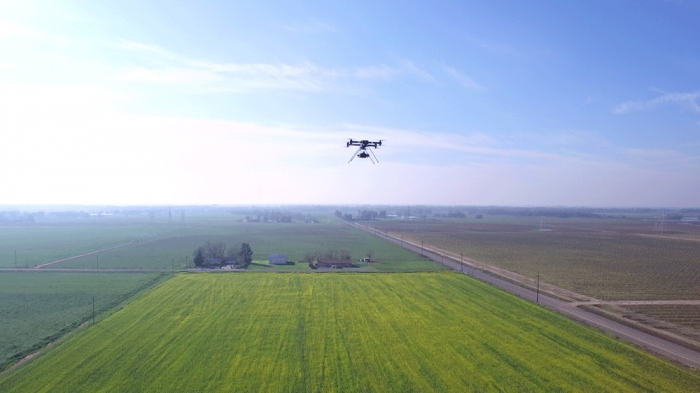Some U.S. Drones Are Getting Longer Leashes
Since Monday, companies have been allowed to fly drones for commercial purposes in U.S. airspace. But the new rules include restrictions that limit the moneymaking potential of unmanned aircraft. Drones may not be flown at night, over people, or beyond a pilot’s visual line of sight.
That last rule keeps drones within one nautical mile (1.15 miles) of their operator, for fear that they will interfere with other aircraft. It complicates jobs such as surveying large farms or industrial facilities. But progress is being made toward letting drones roam further.
PrecisionHawk, a drone company based in Raleigh, North Carolina, recently completed the first phase of a Federal Aviation Administration project investigating how that rule might be loosened. Other companies have tested longer flights at FAA test sites. And this week PrecisionHawk was granted the first exemption from the line of sight rule allowing commercial operations on a longer leash.

Other companies can apply for similar waivers. The FAA plans to watch how they fare with a view to amending its rules to permit longer drone flights by any company.
PrecisionHawk started staging test scenarios in which a pilot flew a drone out of view under an FAA program called Pathfinder last year. They challenged pilots to keep their drone safely away from crewed aircraft, such as single-propeller planes, microlights, and paragliders also flying in the area. The tests were repeated around the country in varying weather conditions.
PrecisionHawk reported to the FAA earlier this month that its results showed that pilots could keep their drones safe as much as three nautical miles (almost 3.5 miles) away just by looking out for other aircraft. That led to the FAA on Monday granting the company a waiver from the rule limiting flights to line of sight.
That sees the agency repeat a tactic used before the new rules permitting commercial flights took force Monday. It granted thousands of waivers from the ban on flights as a way to let companies and regulators learn about drone use. The FAA has said PrecisionHawk can now train other companies to secure the new kind of waiver allowing flights beyond line of sight.
Thomas Haun, an executive vice president at the company, says even being able to operate up to just three miles away significantly increases how useful and cost-effective drones can be. “This allows for a much larger area of operations and gives the ability to perform missions that previously you could not perform at all,” he says. “It will help the commercial drone industry move forward.”
Haun says that making it possible to fly over larger areas would be particularly valuable in agriculture, which his company and others say is a leading market for the use of drones (see “10 Breakthrough Technologies 2014: Agricultural Drones”). Mining operations and industrial facilities should also benefit, he says.
Jesse Kallman, head o f business development and regulatory affairs at Airware, which helps large companies use drones, is confident that the FAA will move to let everyone fly drones further. The company is already talking with insurance companies about how that would change the use cases for drones, he says. For example, after a natural disaster, insurance crews could quickly survey many blocks of a city to see how many homes were affected.
However, letting drones fly more than three nautical miles from their pilot will require technical assistance to keep everyone safe, says Haun. As the FAA’s Pathfinder program continues, PrecisionHawk will investigate what sensors or obstacle avoidance systems could be required for drones that want to roam even further.
Keep Reading
Most Popular
Large language models can do jaw-dropping things. But nobody knows exactly why.
And that's a problem. Figuring it out is one of the biggest scientific puzzles of our time and a crucial step towards controlling more powerful future models.
The problem with plug-in hybrids? Their drivers.
Plug-in hybrids are often sold as a transition to EVs, but new data from Europe shows we’re still underestimating the emissions they produce.
Google DeepMind’s new generative model makes Super Mario–like games from scratch
Genie learns how to control games by watching hours and hours of video. It could help train next-gen robots too.
How scientists traced a mysterious covid case back to six toilets
When wastewater surveillance turns into a hunt for a single infected individual, the ethics get tricky.
Stay connected
Get the latest updates from
MIT Technology Review
Discover special offers, top stories, upcoming events, and more.